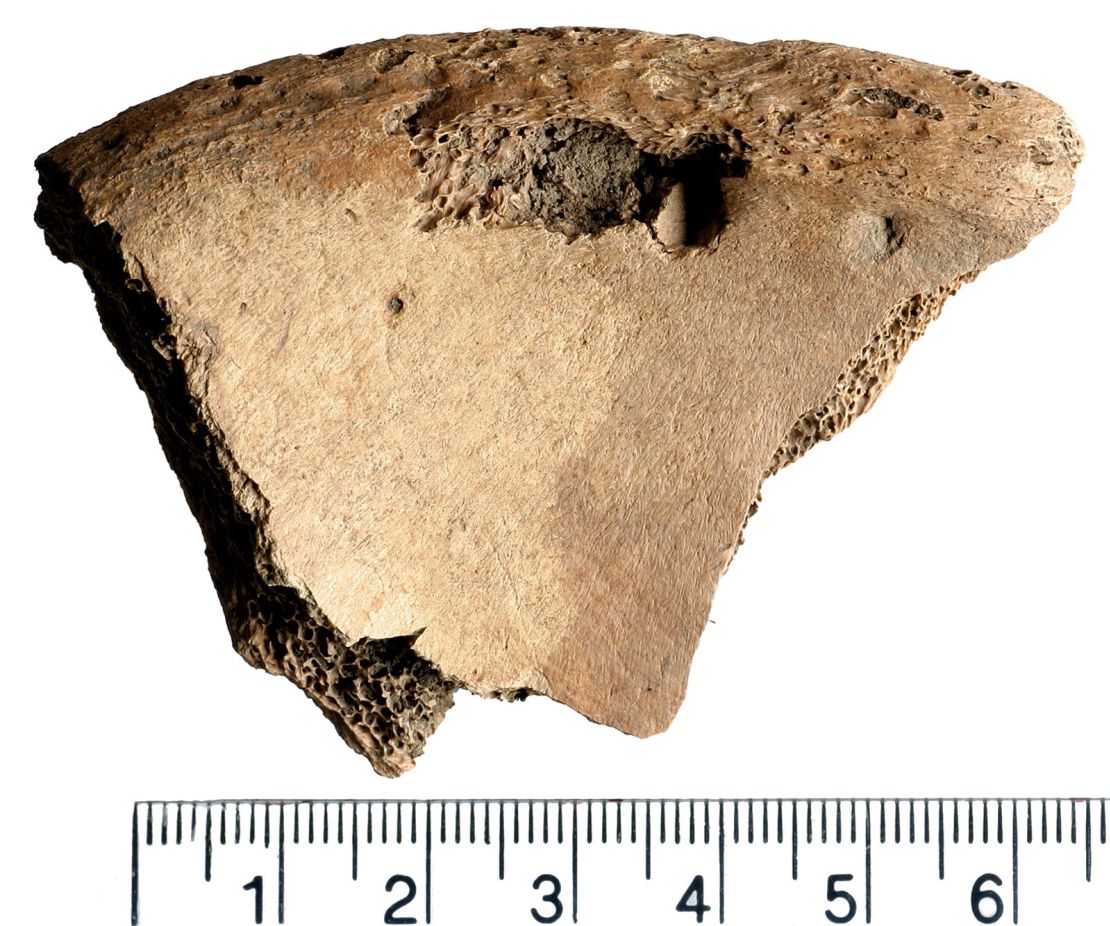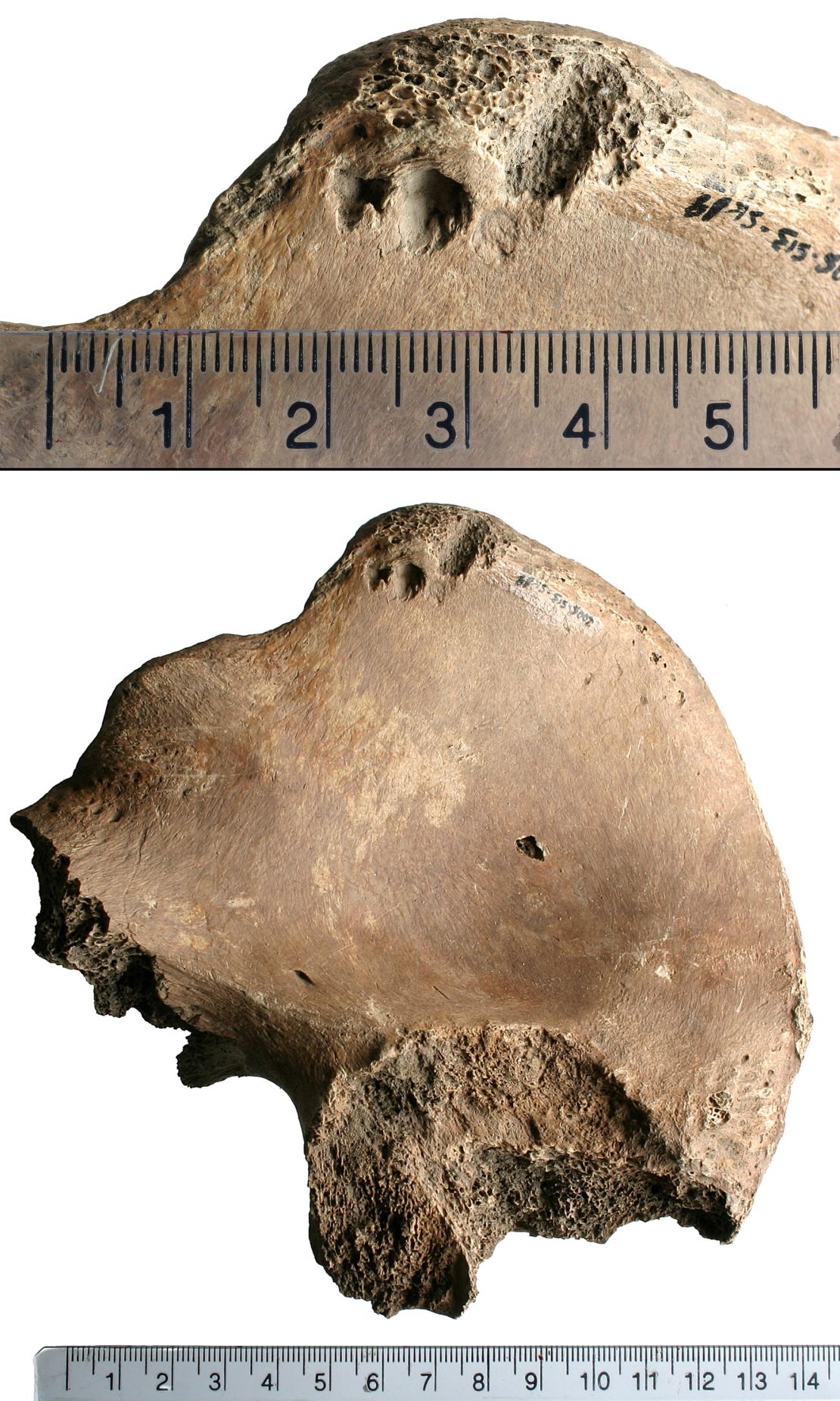Register for the Wonder Theory Science newsletter from CNN. Explore the universe with news on fascinating discoveries, scientific progress and more.
Cnn
–
A skeleton recovered from an intriguing cemetery from the Roman era in England can mark the first physical evidence of combat between gladiators and animals, according to new research.
The skeleton of a man, who was between 26 and 35 years old at his death, was found with marks of bite of a large cat – probably a lion – on the basin. The man died and was buried in a tomb between 1,825 and 1,725 years in an area now known as York, England. The study was published Wednesday in the journal Plos One.
Archaeologists from the Archaeological Trust York have recovered the remains of Driffield Terrace, which they consider as a Gladiator cemetery.
The place is along the old Roman road leading to York and obtained its designation of cemetery after archaeologists announced the discovery of 82 skeletons of young valid men in a 2010 documentary entitled “Gladiators: Back of the Dead”.
While the Romans have documented fights between humans as well as humans and animals in works of art and files, the physical evidence of gladiators and battles they were confronted with entertaining others are rare, the authors of the study said.
“For years, our understanding of the fights of Roman gladiators and animal shows has strongly supported historical texts and artistic representations,” said Tim Thompson, author of the main study, professor of anthropology and vice-president of students and learning at Maynooth University in Ireland, in a press release. “This discovery provides the first direct physical proof that such events took place during this period, reshaping our perception of the culture of Roman entertainment in the region.”
The results highlight the large -scale effects of the Roman Empire through England, showing that the gladiator arenas that presented animals imported from other countries were part of the culture and lifestyle far from the scope of the Colosseum in Rome.
The burials did not take place in colonies during the Roman period, leading the dead to be cremated or buried alongside main roads, the authors said in the study.
When the construction of the region led to archaeological assessments in 2004, the researchers discovered the Driffield Terrace cemetery. Many remains for men have gone proofs of training, trauma, healing injuries and unusual funeral rites such as decapitation. Analysis of the enamel of the teeth also showed that men came from a wide range of Roman provinces from around the world.
While the researchers conducted in -depth studies on the cemetery and its remains, a mystery persisted: a skeleton with unexplained depressions on the pelvis that looked like the bite of a carnivore.

As part of the new study, the researchers created three -dimensional analyzes of brands and compared them with bites of various carnivores. The comparison showed that bite brands were likely from a large cat, probably a lion.
“The bite marks were probably made by a lion, which confirms that the skeletons buried in the cemetery were gladiators, rather than soldiers or slaves, as the first osteological confirmation of human interaction thought with great carnivores in a fight or entertainment in the Roman world,” Osteochae. statement. Holst is also the director general of York Osteoarchaeology, who specializes in excavation, analysis and human remains.
The surviving texts and works show that such meetings between men and beasts were staged during the arena glasses in the Roman Empire, said Kathleen Mr. Coleman, professor of James Loeb classics at Harvard University. Coleman was not involved in research.
“But the images can go to areas where the events themselves do not occur, so they are not conclusive evidence that animal fight took place there,” said Coleman. “This is why the new skeleton is so important.”
An additional analysis of the man’s bones showed that he had recovered from malnutrition when he was a child but had problems of spine due to the overload of the back and the inflammation of his lungs and his thighs.
The man was probably a bestarius, or a gladiator who accumulated against the animals and whose role was fulfilled by volunteers or slaves.
“(Gladiators) could become famous and could buy their freedom, so we have a better understanding of the complex social world they lived in,” said Barry Molloy, an associate professor at the Archeology School of the University College Dublin, who was not involved in the study. “What we see in art could be considered as” the coups of money “or what we could imagine that the Romans considered the coolest killed ” that the boss of art wanted to show his audience. You can imagine in the arena, with an armed person fighting for his life, the winner of human battles vs animals was not a conclusion of the order. ”

The gladiators were considered athletes at the time, and their owners wanted them to win so that they could fight again, said study authors. The lion’s bite has never healed, which suggests that it led or caused her death, and the man was beheaded after death. Although it is a funeral rite for some in Roman times, researchers think that man was beheaded as a mercy after the lion bite.
“This is an extremely exciting discovery because we can now start to build a better image of what these gladiators were in life, and this also confirms the presence of great cats, and potentially other exotic animals, in arenas in cities like York, and how they also had to defend themselves against the threat of death,” said clever.
But how did a gladiator arena and a lion end up in northeast England?
Images of combat gladiators, sometimes with each other or with animals, commemoralized in mosaics and old pottery remember the Roman colosseum, “which would have been the Wembley stadium of the classical world of the Archeology Department of the University of York. Jennings did not participate in the new research.
But such brutal sporting events had an extensive scope beyond the main Roman territories, and although an amphitheater probably existed in Roman York, it has not yet been discovered, said Malin.
York began as the Roman city of Eboracum, which was founded as a fortress in the year 71 AD, and the soldiers stayed there until the end of the Roman period at the beginning of the fifth century, according to the study authors. Researchers think that the events of the Gladiator style Arena were there as late as the fourth century because the city welcomed many senior generals and politicians, as well as Constantine, who was proclaimed emperor by his troops in Eboracum in AD 306.
The new discoveries indicate that Great Britain was well integrated into customs and systems of the Roman Empire at its peak and provides evidence that Roman entertainment was spread in the Empire, said Jaclyn Neel, an associate professor of Greek and Roman studies at Carleton University in Ottawa. Neel was not involved in research.

But the presence of Lions, rather than the wild boar and the local deer, in York, provided a unique touch to researchers. The mosaics, such as the “Corridor of the Great Hunt” located on the UNESCO World Heritage website of the Villa Romana del Casale in Piazza Armerina, Sicily, depict how large animals were captured and transported to Rome for sport.
“The exact context of this meeting could have been a competition between a professional fighter and the lion, which would have been exciting for spectators, who could even have bet on who would win,” said Coleman. “Or it could have been a form of execution in which a criminal is exposed to wild animals, in which case the spectators would probably appreciate the satisfaction of seeing justice doing, because a criminal would not arouse any mercy.”
The lion was probably transported along the well -established supply channels which also transported supplies in bulk of wine, oil and cereals through continental Europe and the Mediterranean in York since it was a legionary base, said the co -author of the study, Dr. Pearce, reader in archeology and classics of King’s College in London. Large cats like the Lions would have been captured in North Africa, then transported through the sea before being moved through a network of rivers and finally the London road in York.
“As a tangible witnesses of shows in the Roman amphitheats of Great Britain, the bits of beer help us to appreciate these spaces as parameters for brutal demonstrations of power. They make an important contribution to the decrease of our Roman past,” said Pearce in a press release.
If the man who faced the lion was a professional hunter, as indicated in the study, the entertainment of looking at man and a lion interacting in the arena probably resembled bullfighting in Spain, said Neel.
“I think it is important not to exotize the Romans-they knew much more death than most modern North Americans, but that does not mean that they have tried to kill as many people as possible,” she said. “Roman culture has stressed man’s control over nature. A hunt for animals, for me, is a theatrical reconstruction of this control. The Romans thus used the beast hunts to strengthen a feeling of human superiority over nature, even for spectators. ”
The skeleton will be part of the Roman exhibition “DIG: An Archaeological Adventure in St. Saviorugate” in York, while a 3D scan of the bite brand and other representations of gladiator fights in Great Britain is one of the “Gladiators of Britain”, an exhibition of partnership of the British museum currently exhibited at the Dorset Museum & Art gallery.


